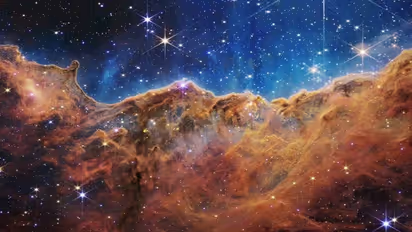NASA's Webb reveals cosmic cliffs, glittering landscape of star birth | See breathtaking pics
The world is getting its first glimpse of the full capabilities of NASA's James Webb Space Telescope, a collaboration with ESA and CSA. The first full-color images and spectroscopic data from the telescope were released during a televised broadcast from NASA's Goddard Space Flight Center in Greenbelt.

The world is getting its first glimpse of the full capabilities of NASA's James Webb Space Telescope, a collaboration with ESA (European Space Agency) and CSA (Canadian Space Agency). The first full-color images and spectroscopic data from the telescope were released during a televised broadcast from NASA's Goddard Space Flight Center in Greenbelt, Maryland, on Tuesday, July 12, 2022, at 10:30 a.m. EDT (14:30 UTC).
Carina Nebula
This scene of "mountains" and "valleys" dotted with brilliant stars is really the edge of the Carina Nebula's adjacent, young, star-forming area known as NGC 3324. This image, captured in infrared light by NASA's new James Webb Space Telescope, exposes previously unseen areas of star formation for the first time.
Webb's supposedly three-dimensional image, titled the Cosmic Cliffs, resembles jagged mountains on a moonlight evening. In actuality, it is the edge of NGC 3324's massive, gaseous cavity, and the highest "peaks" in this view are around 7 light-years high. The strong UV radiation and stellar winds from extremely large, hot, young stars situated in the core of the bubble, above the area visible in this image, have cut the cavernous area from the nebula.
Also Read | Webb Telescope’s 'first' images to be made public on July 12; Know when and where to check them
Southern Ring Nebula
For millions of years, the dimmer star at the centre of this image has been sending out rings of gas and dust in all directions, and NASA's James Webb Space Telescope has shown for the first time that this star is shrouded in dust.
Two cameras aboard Webb obtained the most recent photograph of this planetary nebula, known colloquially as the Southern Ring Nebula and catalogued as NGC 3132. It is around 2,500 light-years distant.
Webb will help astronomers to learn more about planetary nebulae like this one, which are clouds of gas and dust ejected by dead stars. Understanding which molecules are present and where they are located within the shells of gas and dust can aid researchers in refining their understanding of these things.
Also Read | President Joe Biden to unveil first teaser image clicked by James Webb Telescope tonight
SMACS 0723
NASA's James Webb Space Telescope has created the most detailed and clear infrared picture of the cosmos to date. This image of galaxy cluster SMACS 0723, known as Webb's First Deep Field, is rich in detail. Thousands of galaxies, including the tiniest infrared objects yet detected, have appeared in Webb's perspective for the first time. This sliver of the huge cosmos takes up about the size of a grain of sand held at arm's length by someone on the ground.
Also Read | NASA releases the deepest ever image of the universe
Stephan's Quintet
Stephan's Quintet, a beautiful collection of five galaxies, is well recognised for its appearance in the holiday classic film "It's a Wonderful Life." Today, NASA's James Webb Space Telescope sheds fresh insight on Stephan's Quintet. This massive mosaic, which covers almost one-fifth of the Moon's diameter, is Webb's biggest image to date. It has about 150 million pixels and is made up of over 1,000 different picture files. Webb's findings shed fresh light on how galactic interactions may have influenced galaxy evolution in the early cosmos.
Webb's strong infrared vision and exceptionally high spatial resolution reveal previously unseen elements in this galaxy group. The picture is adorned with sparkling clusters of millions of newborn stars and starburst areas of new star formation. Gravitational interactions are pulling sweeping tails of gas, dust, and stars from many galaxies. Webb records massive shock waves when one of the galaxies, NGC 7318B, smashes into the cluster.
Also Read | James Webb Space Telescope launch: World's largest, most powerful observatory successfully lifts-off